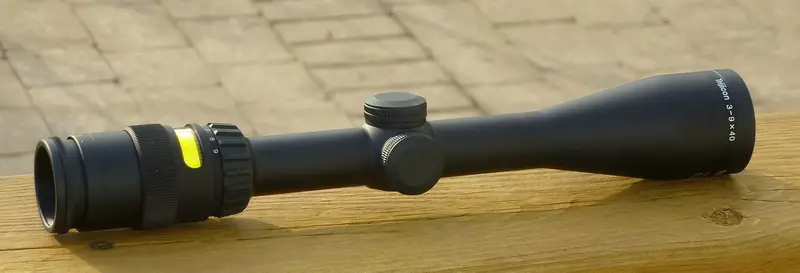



Trijicon Accu-Point 3-9 x 40 Riflescope

There has been significant reader interest about Trijicon riflescopes and I've never taken a close look at one, until now, so hopefully this will rectify my oversight. The tested scope is an Accupoint 3-9 x 40 with standard crosshairs and an amber dot model TR20-1. The primary area of interest is the self-illuminating amber dot that is augmented by a fiber optic array in daylight use. The scope itself has fairly conventional specifications for a one inch main tube hunting scope with a 40mm objective.
Magnification:
3x-9x
Objective Size: 40
Bullet Drop Compensator No
Length (In) 12.4
Weight (oz) 13.4
Illumination Source: Fiber Optics & Tritium
Reticle Pattern: Standard Duplex Crosshair
Day Reticle Color: Amber
Night Reticle Color: Amber
Eye Relief: 3.6 to 3.2
Exit Pupil: 13.3 to 4.4
Field of View (Degrees): 6.45 to 2.15
Field of View @ 100 yards: (ft) 33.8 to 11.3
Adjustment @ 100 yards (clicks/in): 4
Tube Size: 1 in.
Housing Material: 6061-T6 aluminum, hard coat anodized per MIL-A-8625,
Type III, Class 2 dull & non reflective
Adjustment Range: ± 25 MOA (± 7.4 mils) minimum
The tritium lamp is warranted to glow for fifteen years from date of purchase, then it can be replaced by Trijicon. My understanding is that a 20 – 25 year lifespan on the original tritium element is typical. Most Trijicon product is manufactured in Michigan, but this AccuPoint scope is fundamentally Japanese product. Final assembly and packaging, including the installing the fiber optic/tritium illumination module and setting the parallax is performed at their plant in Michigan.
The huge advantage of the Trijicon Accupoint is the lack of batteries. Not only is it impossible to have dead batteries, but losing the battery housing and associated parts means a substantially lighter scope as well. No buttons to push, nothing to turn on in low light, the amber dot is automatically there just when you need it.
In daylight, the amber dot is as visible as you choose to make it. There is a very easy to use integral shroud that lets you control the fiber optic level. Looking at the fiber optic in artificial lighting does not at all do it justice. Outdoors, it is extremely bright and clear. Although my test scope has the amber dot, you have your choice of other reticles as well, including a green dot, the triangle reticle, or a Mil-Dot crosshair with illuminated center dot.
An issue with many scopes isn't the reticle, it is that you run out of reticle before you run out of shooting light. That's the magic of the Accupoint, along with the lack of battery hassle. A further problem, common in several rheostat illuminated reticle scopes is that the reticle is way, way too bright and cannot be turned down to a non-blinding level. That, thankfully, isn't the problem here. In low-light or even at night, you have all the dot you need to precisely place a shot without it ever becoming distracting, much less overwhelming.
While
hardly an entry-level scope at something like $900 retail and $750 or
so street price, it is extremely well-made, has excellent image quality,
and works exactly as promised. Unique among magnified optics, the lighter
weight and lack of relying on batteries give it tremendous appeal compared
to the more common illuminated reticle genre of scopes. If instant target
acquisition is important to you in dingy, low-light, low contrast conditions,
this Trijicon Accu-Point is quite worthy of your consideration.
Copyright 2012 by Randy Wakeman. All Rights Reserved.

Custom Search

